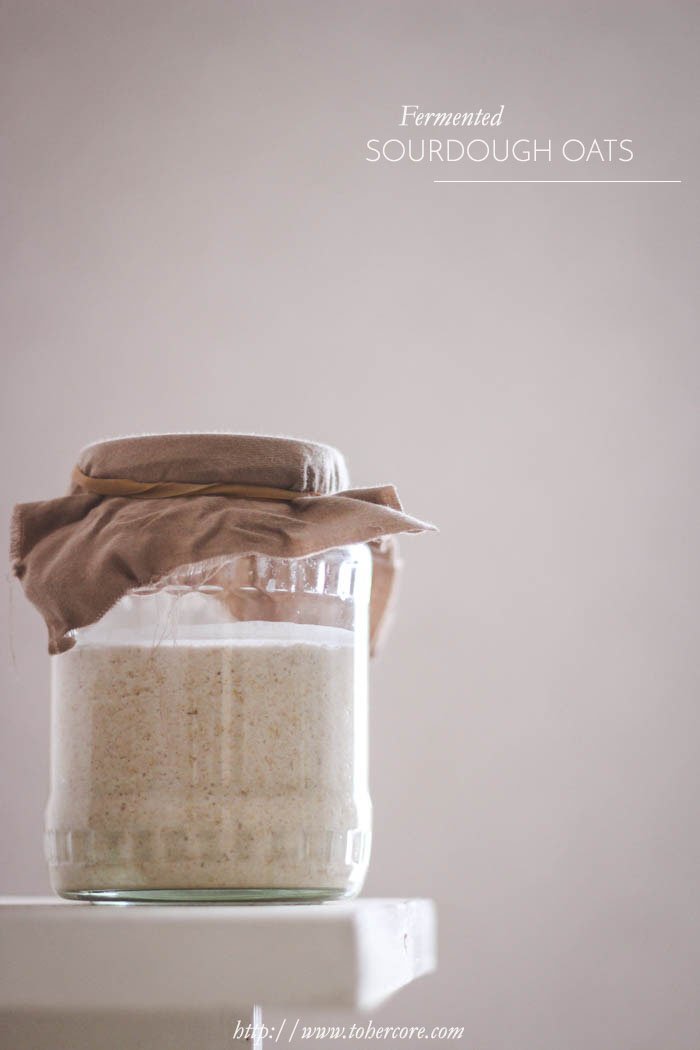
One of the oldest way to prepare food, which is not only cost effective but also great for your gut health, is by fermenting them. We have seen a growth in popularity of fermented food and drink such as kombucha, sauerkraut, kimchi and kefir as we become more and more aware of the connection between gut health and our overall health. And while fermented foods and drinks can be expensive to buy, they are very inexpensive to make yourself at home.
One I have been experimenting with a bit lately is fermented oats – or sourdough oats as I have been calling them, as the process is a little similar to making sourdough bread (well, asides from the actual bread part – though in theory you could use the fermented oats starter to make bread from… another challenge to experiment with!) The idea is that you mix the oats with water and leave at room temperature, loosely covered, for a few days to ferment.
To make your starter, you simply need to mix oats with a slightly greater amount of water. When you first combine the two, the mixture should be a little thicker than “gluggy”, but not so runny that it separates too much. I usually use around 1 1/4 cups of water per cup of oats. The mixture will look quite thick at this stage as you can see in the image below.
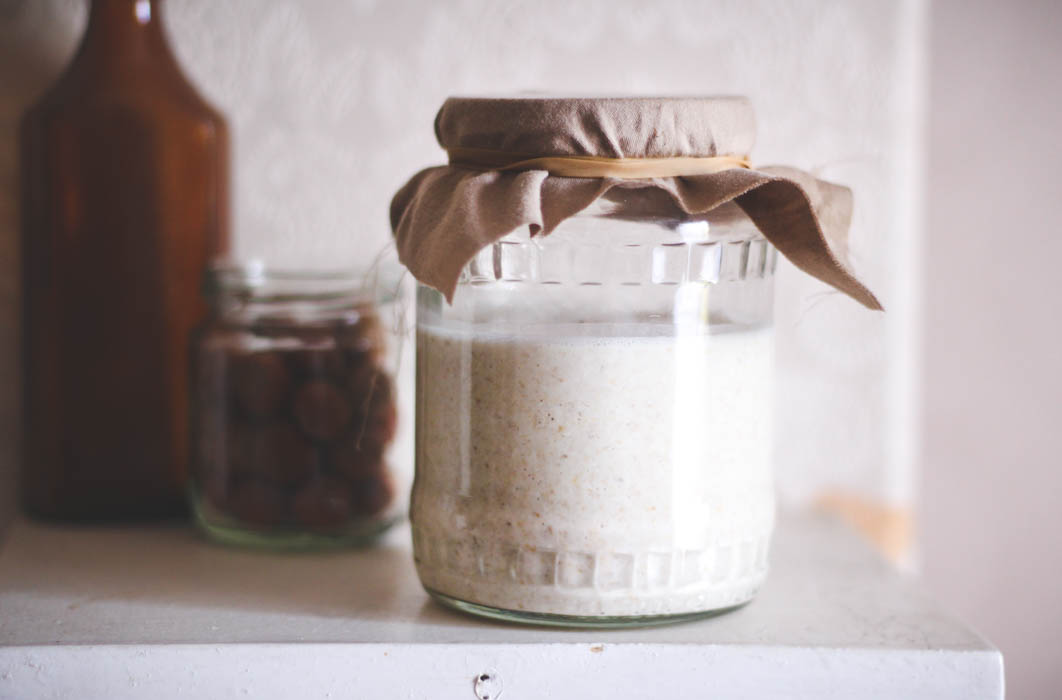
The speed of the fermentation will vary depending on the temperature inside your home, but it usually takes around two days for your oats to ferment, slightly longer if your house is cooler and slightly less time if your house errs on the warmer side.
Your starter will be ready when bubbles start to form (see image below) and it has a slightly soured, yeasty smell. The taste of the oats here will be similar to the scent, and this will continue to develop the longer you leave the grains to ferment. Once you are ready to use the oats, remove the desired amount, replace with the same amount of raw oats and water, stir well and then leave again to sit and ferment for a few days.
If you do wish to speed up the fermentation time or give it a kick start, you could add some whey or kefir in the initial mix, however I usually find that this isn’t necessary and the grains ferments fine without it.
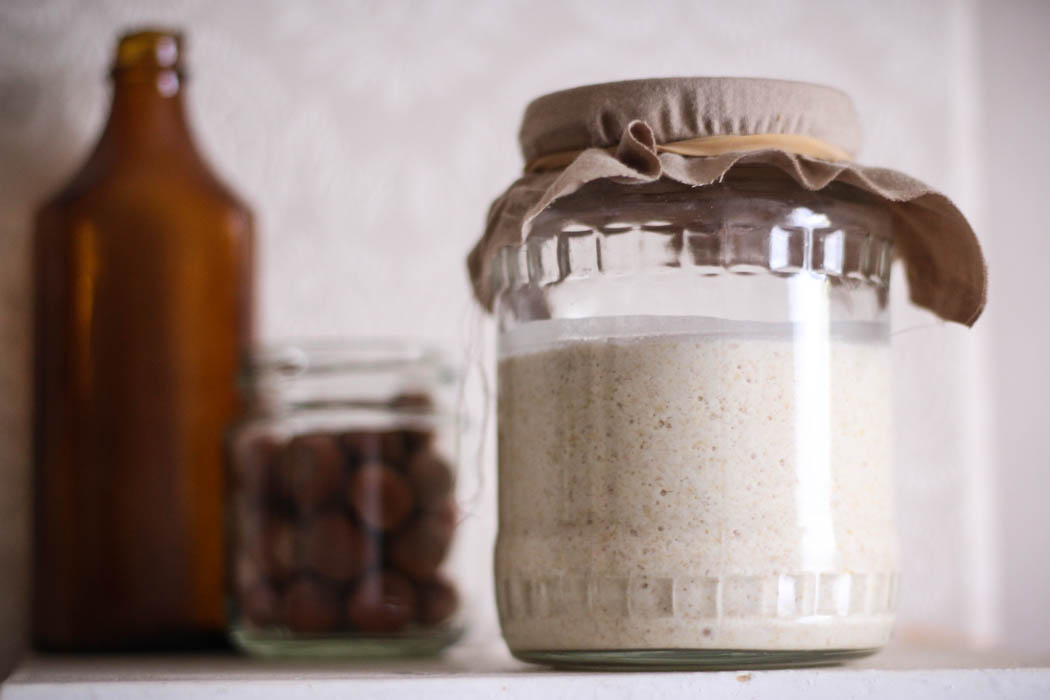
Once you have your fermented starter, you can use it as part of your normal oat recipe to make either cooked porridge or raw bircher muesli/overnight oats. You could of course eat the fermented oats by themselves with no additional oats added, but I prefer to use them as a starter to prepare my normal oat dishes – I find that the flavour can be a little overpowering otherwise, though I assume that it’s a flavour you could easily get used to. You could also counteract this by shortening the fermentation time to reduce the sourness of the oats. If you were wanting to eat the starter only, I suggest mixing it with some almond milk to thin it out a little, and adding in a sweetener – I really like molasses in mine, though any other sweetener would work well here. You could also try blending it which will make it smoother and a little creamier too.
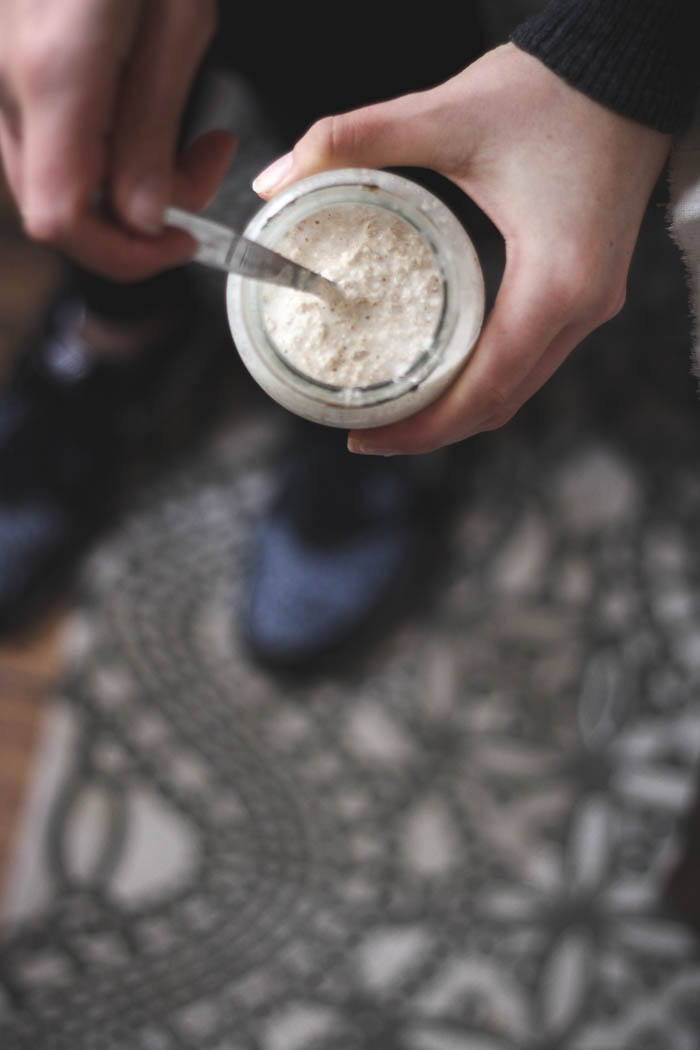
Troubleshooting/Tips
- Try to keep the starter at a stable temperature while fermenting. You don’t need to be too fussy about this – it’s not as finicky as other ferments such as sourdough bread starter or yoghurt – but usually it will work best if you can keep the temperature fairly consistent, so placing it in a cupboard and/or out of direct sunlight would be ideal.
- I also try to use a wooden or glass spoon – anything not metallic as I know from past experiences that metallic utensils don’t mix well with fermenting foods.
- You can use any type of oat grain to make your starter. I usually buy organic oats from a local wholefoods store which are rolled and cracked – essentially you want the starch inside the grain to be exposed as the wild bacteria will feed off this starch during the fermentation process, creating the beneficial yeasts and acids. If you use whole oats make sure to break them up well in a blender or flour mill until they resemble oat grouts – you can do this in bulk and store them in a large jar ready to feed the starter with so that you don’t need to process them each time.
- 1 cup oats (rolled, whole or oat groats)
- 1¼ cup water
- ½ cup rolled oats
- ½ cup fermented oats starter
- ⅔ cup liquid (milk of choice, water etc)
- 1 Tbsp sweetener of choice (molasses, honey, maple syrup)
- ¼ tsp salt
- ½ cup rolled oats
- ½ cup fermented oats
- ½ cup liquid (milk of choice, water etc)
- 1 Tbsp sweetener of choice (molasses, honey, maple syrup)
- To make the fermented oats, first add the oats to a blender and pulse a few times to break them up a little, exposing some of the starchy insides. Add to a glass jar with the water and mix until combined. Place a cloth over the top, secured with a band, and leave to ferment for 48 - 72 hours. after this period, you can remove part of the starter to make porridge with, and add the same amount of fresh oats and water back to the jar. Mix thoroughly, and leave to ferment another few days before using again.
- To make the Sourdough Porridge, combine all ingredients in a pot and cook over low heat 10 - 15 minutes until creamy. Enjoy topped with your favorite toppings (eg crushed nuts or seeds, fresh fruit, yoghurt etc).
- To make the Sourdough Bircher Muesli, add all ingredients to a jar and mix well to combine. Add a lid, and then store in the fridge overnight. Eat in the morning topped with your favorite toppings (eg crushed nuts or seeds, fresh fruit, yoghurt etc).
Are you a porridge lover? Be sure to check out my complete guide to making healthier (and yummier!) wholegrain porridge.
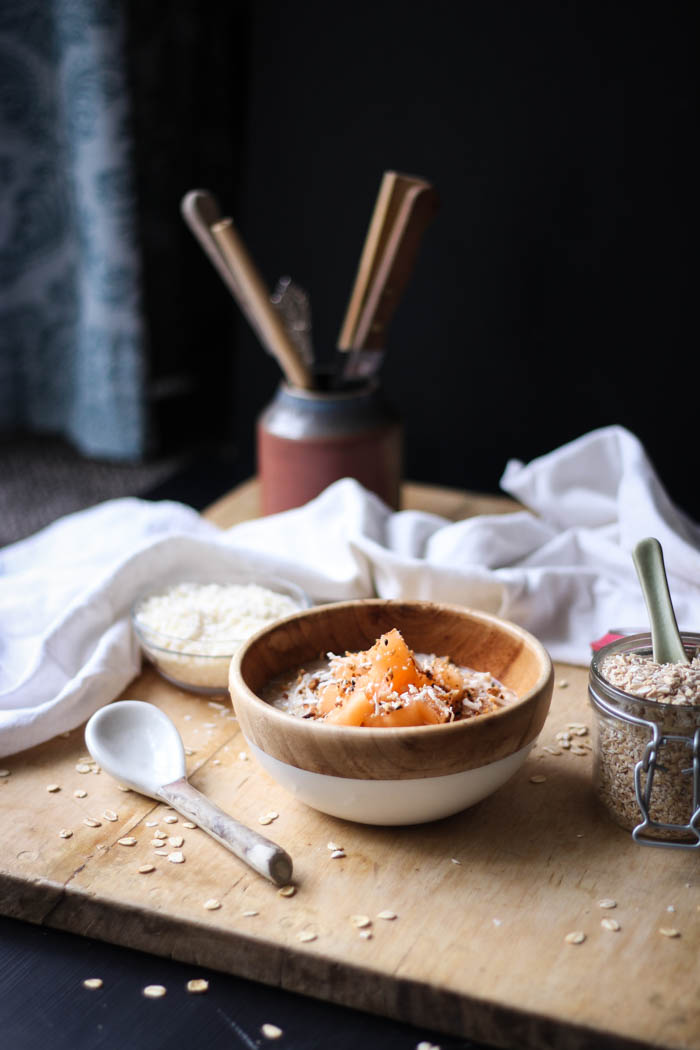
This is an awesome idea lady! I have never seen this before :)
I am trying oats again in December to see how I go with them and perhaps this would be the best way to start :)
Thanks Lauren! Fermented oats should definitely be a little easier to digest so I think would be a good choice to start with :) You’ll have to keep me posted with how it goes!
I LOVE this idea. Can’t get my hands down. I have to start making some right now. That’s the only annoying thing about fermenting – you have to wait before you can enjoy it :)
Do you just feed the sour oats starter as you’d do with normal sour dough starters?
Thanks Josefine! Haha, yes it is a little annoying that these things take a little time, I get so impatient too! And yes, you just need to feed the starter the same way you would a normal sourdough starter – I’ll update the recipe to reflect this :)
i’m so excited to see this post! thanks for sharing your method. i’m totally inspired and love the idea of having a continuous batch around. i love oats but they’re so rough on my stomach if i don’t soak them ahead of time–so having a spoonful of this in the soak is going to be another level of health+comfort that i am all about. thank you! xo
Thanks so much Jaime – I’m excited that you’re excited :) I think fermenting the oats should definitely help – I’d love to hear how you go if you try this out x
Hey Dearna! Should you put the oats in the fridge once it’s fermented? Or do you just keep using and topping up at room temp? Going to give this a go this week! X
Hi Liberty – I keep them on the bench or in the cupboard and keep taking out a portion of the fermented oats and “feeding” it with dry oats/water and then repeating. This means you will need to use some around every second day or so – if you wanted to eat them less often you could refrigerate the starter to slow down the fermenting process. If you want to use some of the starter to make bircher-style muesli/overnight oats, I usually mix this and then leave it in the fridge overnight – you could leave it on the bench, but it would continue to ferment and may be quite sour by the morning.
x
Sourdough oats?! Love it Dearna! And I especially love how you use them in Bircher Muesli, one of my favorite warm weather breakfasts.
Thanks Katie – sourdough bircher muesli is lovely, it has a lovely depth of flavour :)
I really like the wooden bowl. Please let me know where I can buy it.
Hi Debbie – its cute isnt it? I actually bought it on holiday in Bali last year from a little boutique in Seminyak.
im 66 now and quite concerned about my health..and its rare that i find posts similar to yours..
when others talk about fermenting oats..they always talk about adding a starter..you seem to believe..and i agree.. that one can get great benefits from just letting the oats do there own thing for a few days..am i right ? IF IM NOT.. PLEASE LET ME KNOW HOW TO GET THE BEST RESULTS for the probiotic effects of just letting the oats do there thing for a few days… thanks again …jimmy.
Hi Jimmy, thanks for stopping by. The bacteria which is needed for the oats to ferment can occur naturally – though I do sometimes use a little whey or kefir to lend a helping hand when starting the process, especially in winter when its colder. All fermented grains however – oats, sourdough bread starters etc should be able to thrive simply on flour/grain and water, so you should be fine to just use the oats and water to make the starter from, and then to continue feeding it. Good luck Jimmy – and great to hear that you are taking such an interest in your health and particularly your gut health, it’s so important to ensure good overall health. – Dearna
Most of the oat flakes in Canada and the US(?) will have been heated to kill of an enzyme that reduces the shelf life of the flakes. I found a supplier of oat grains and flake them myself with a flaker. The grains are perfect as they will grow a plant if put into soil. So unless the grains of oats are not alive when made into flakes and not heat treated, the microbial composition might be risky. Also if one wants to mill the oat grains, it has to be remembered that oat are rather fatty compared to other grains such as spelt or Kamut.
I will try the same as with spelt grain to make sourdough from scratch, but I worry about the rancidity.
Hi, I absolutely love this recipe and had the Bircher for breakfast days in a row and don’t anticipate that changing soon.
I have one question (I’m new to fermenting): How long do you keep going with the starter and when if at all does it need to go in the fridge?
Thanks
So glad you like it Jen! :) I don’t have a set time – there are so many variables with fermenting! – but I usually start over again once every month or so… In theory though you should be able to keep adding a little starter to a new batch and just keep a continuous cycle going. It will depend a little on how warm it is in your house and how quick it is fermenting – good luck with it! :)
how can you make sure that the bacteria in the fermented food don’t produce any harmful substances? how do you prevent putrefaction?
I believe this can be avoided by controlling the temperature and salinity to give an advantage to the good bacteria. For even more control, start off with cooked ingredients, then add the specific bacterial culture you’re wanting at the start of the fermentation.
Interesting idea, will try. For years now I’ve mixed my morning oatmeal with water in the pan I’ll cook them in at night before I go to bed. In the morning, cook as usual, though often it requires a bit of extra water to get the ‘right’ texture. Flavor (to me) is lovely. Makes me salivate when I smell it, (classic response to fermented foods). I use a little honey or maple syrup to sweeten, and eat with homemade yogurt. Stainless steel pan, but I’ve never noticed a problem, and in summer it gets quite sour.
Have always seen the admonition to avoid metal, but never thought of it when doing this. Wonder if it’s connected to traditional pans, like cast iron or aluminum, both of which are highly reactive? I’m curious now, have you tested this metal thing further since this was posted?
Hi Lynetta! I love your method, thanks for sharing, I’ll give it a go too :) And no, I haven’t tried making this using anything metal. Though my efforts sometimes are a little lax, and it does seem quite resilient. I’ve had issues before using metal when making kefir, but I think that kefir is a lot more finicky so that may be the reason… D x
I tried this. By the time I had bubbles (roughly 72 hours) I also had mold. How is this to “live” on the countertop with no refrigeration and not get moldy?
Hi there – fermentation in general can be a tricky thing to get right when starting out as there are so many factors that can impact the end product – the air temperature, the type of oats you are fermenting, the water you are using, whether or not you add a starter (and if so, the type of starter), as well as whether any other bacteria gets in to the jar (ie if it’s not cleaned properly, or placed near something else eg fresh vegetables, brewed kombucha etc)…
Mould can grow if the temperature is too warm, or if there is an incorrect balance of bacteria and yeast… I would suggest using organic oats, filtered water, and a shorter fermentation time. Hope this helps – good luck :)
Hello, I wonder if the fermentation will help with the phytic acid of the oats. I have breastfeed my baby exclusively for 6 months and now he has started with food. I want to make oats porridge to him. I was thinking to put oats, water and a bit of ecologist flour to ferment for 12 hours, I dont know if this is enough and then I will cooked then and mix with breast milk. Or should I mix the oats just with breast milk and let it ferment? Could PLEASE someone enlighten me. I would REALLY appreciate it. Thanks with my heart.
Hei I don’t see bubbles because the mix became gluggy or it seem to have too much water. Do you thin that the fermentation took place even if it was gluggy? Thanks
So happy to have learned this from you. I was given traditional sour dough made with flour last week and have been feeding it almond meal. This is turning out to be costly so the idea of using oatmeal as a replacement is brilliant. Here’s an idea for a recipe, add an egg, oatmeal and blueberries to make health oatmeal sourdough pancakes !!! Thank you
Ooh, I love the idea of sourdough oat pancakes, will have to give this a try! Thanks Julie :)
Hi Dearna! I found the fermented oats recipe on vegpeace.org and decided to give it a try. I have to say that the fist time I tasted the final result, it felt too overpowering the flavor. After doing some extra research I found this post. Thanks for the recipes… definitively more palatable the way you suggest.
Hi !sa, thank you so glad you liked it! Fermented foods can have a very strong flavour so I definitely think its worth experimenting to find ways of doing it that taste good :) Thanks for taking the time to comment x
Wonderful! I am wondering if you have ever made an oat sourdough starter for bread? I have several going and they don’t seem to be fermenting the same way other flours do. Hopefully you have some advise?
Hi Suzan! Sorry, but I have not tried to use the oats as a base for sourdough bread but very intrigued about this idea, I’ll have to do a little experimenting :)
Love love love it! I was wondering how your experiments went. Did you get to make sourdough bread with the oats starter? I’m really interested in this.
Thanks!
I am inclined to agree with @Quebec City. The fermentation of rolled oats without culturing is questionable. After de-hulling, rolled oats are usually kiln dried, and then steam heated, they are unlikely to ferment without a starter culture.
I have had plenty of success fermenting oats without a starter culture. As stated in the tips section, you want to break them up to expose the starch inside. I usually always buy locally sourced oats which aren’t heated.
Thanks for your recipe and responses! I have been reading up on fermented oats. Yours is about the fifth. Yet you gave some needed guidance. (I have “bread proof” setting on my oven, 100 degrees. Got the start of mold. Too much of a good thing.
Hello tohercore … A question follows.
Found your site searching on whether anyone else has eaten fermented oats without cooking them. It seems like a good way to get nourished with living bacteria, and one can add other ingredients.
Do you ever eat the fermented oatmeal raw?
Hi, yesterday morning I have prepared pancake batter consisting blended oat with some water, bananas and red dates and kept it in the fridge overnight after left it few hours on the counter top.
Today evening I tried to make my pancake, however found that it had fermented inside the fridge with lots of gasses inside. Took it out from fridge and found that it tasted sour. I tried to make few pancakes with some of the batter and it is puffing nicely as if baking powder being added into it. The pancakes tasted sour, is it still safe to be consumed? Can it be used as oat sourdough for bread? If it is usable, can I keep it in the freezer until the next use? Waiting for your prompt reply. Thank you
If you want to get the process going faster, don’t use fermented dairy or anything of the sort. That’ll make it look like something is happening, but won’t actually produce a stable starter any more quickly, because the yeast and bacteria found in those products are not the ones that can live long term in sourdough culture. Instead, get a bit of sourdough starter (wheat, rye, or even teff) and use a few grams of that in your initial mix. The microorganisms in such starters should be pretty happy in an oat-based culture too. If you start a brand-new culture without using sourdough starter, it might be wise to make just a little bit and discard the first few feedings; brand-new cultures can have some pretty funky bacteria in them.
Great! Except I’m not sure why anyone would take the time to ferment oats and breakdown the antinutrients only to add the oxalate soup that is almond “milk”. Real milk is much safer. And much better for the bees, and the environment if you buy pasture raised
Hello,
Stumbled across your recipe and gave it a go. I used quaker steel cut oats, filtered water and a 1/4 teaspoon of applecider vinegar to give it a little kickstart. It was delicious and added the 1/2cup fresh oats and water to the starter and boy is it active now! Just bubbling away. So it’s okay to keep repeating the process and eat it daily?
Much love,
Tj